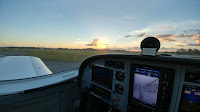I get a lot of questions about buying a SportCruiser/PiperSport. I love the airplane, but all planes have their strengths and weaknesses. One major reason for buying Sally was the support I would get from Piper. Well, that didn't last very long. But the viability of support is a big consideration in making an investment for any airplane.
There was a brief discussion on Facebook about specific things to look for when buying a SportCruiser. I think Bryan summed it up best:
Bryan Woodard A few sport cruiser specifics. Verify nose gear upgraded. Firewall strengthened. No nose gear collapse or any other damage history. Check leather glareshields for burn damage. Check both mains thoroughly for cracks up and down all front, back, sides. Verify landing gear box at the bottom and aft of the seat backs is straight and not damaged. Verify no damage to the entire surface of the tail tie down area. Verify proper canopy alignment and latching. If it is an 09/10 check radiator for evidence of coolant leaks. There was a bad batch of radiators. Verify other typical items such as 5 year rubber, ADSB, BRS life limits etc. Oh and if it’s pre 2012, verify elevator travel to the stop. Where it meets the stop, verify the wear is not excessive and grooved on the part contacting the stop. They remedied this in 2012 with riveted on angle bracket stops. Also, with the elevator in its full nose down resting position, apply slight downward force to the elevator. If it moves or travels more than 1/4” or so you’ve got a problem.Sally has had everything mentioned except ADSB. Automatic dependent surveillance-broadcast (ADS–B) is a surveillance technology in which an aircraft determines its position via satellite navigation and periodically broadcasts it, enabling it to be tracked. It is mandated that any aircraft operating in controlled airspace (which includes most the country east of the Mississippi) have this new technology installed. It comes which significant advantages like traffic information and weather available for free in the cockpit. So I began my shopping for an inexpensive solution and there are many. But there is a glitch. To use my airplane for instruction I must maintain a factory built and approved aircraft. Any changes must be handled by a Letter of Authorization (LOA) from the manufacturer (CSA). I waited patiently. Then an announcement was made by CSA on the SCFLIER Forum
Josh Scheid: Wanted to be the first to let everyone know CSA has approved the Garmin GTX 335 Transponder for use in the SportCruisers and Piper Sports that are requiring this type of equipment for the mandated ADS-B out compliance.
Here is the link to the Service Bulletin No. SB-SC-053: https://czechsportaircraft.com/wp-content/uploads/2018/07/SB-SC-053_R0.pdfNotice that he says "...ADS-B out compliance." That means that this box will transmit (broadcast) which will meet the requirements of the mandate, but I won't be able to take advantage of the benefits of ADS-B in. But I have a GDL-39 receiver. (See previous post). So am I good to go? Back to the forum where I asked what else I might need:
Shawn: Nothing Dave, that's all you need. You'd have the complete solution, you just can't legally wire it up. The problem is you cannot connect your GDL-39 to your 696 to actually DISPLAY traffic and weather in the cockpit. That would be illegal without a LOA from CSA. There's no way for you actually SEE traffic and weather around you on your panel mount 696 as the 696 does not have wifi or bluetooth. You'll have ADS-B out and satisfy the 2020 mandate but you'll see nothing different in the cockpit without a LOA from CSA.
All CSA did was the bare minimum and meet the requirement for the 2020 mandate of ADS-B out only. They did their job, finally. You would have to keep an iPad or other tablet in the cockpit to actually display traffic and weather from your GDL-39. This is just extra clutter in the cockpit in my opinion but if you have no other choice what are you gonna do? Let's hope the next big announcement is the news of CSA actually issuing LOA's so you can request to hardwire your 696 to your GDL-39.Then you'll be golden.But the LOA never came. I'm not golden. I can't hardwire the GDL-39 to my 696 but I could use Bluetooth to make that connection. A 696 doesn't have Bluetooth, a 796 does. Duane comes into the picture as a Knight in shining armor and makes his 796 available. Now I have all the puzzle pieces, I just need an A&P to put them all together for me. (Certus)
But the original question was about a pre-buy. The answer is don't go it alone. There is help out there if you just ask for it.






